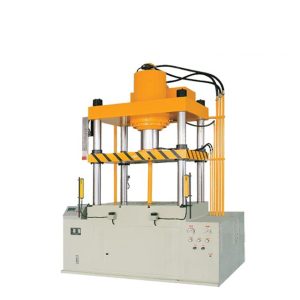Hydraulic press machines have played a pivotal role in industrial manufacturing, evolving significantly since their inception. Today, these machines are at the forefront of technological advancement, providing unmatched precision, power, and efficiency across various industries. This blog explores the historical development, technological innovations, and future trends of hydraulic press machines.

Historical Overview: From Concept to Creation
The concept of the hydraulic press dates back to the early 19th century when British engineer Joseph Bramah patented the first hydraulic press in 1795. Known as the “Bramah Press,” this invention utilized Pascal’s law, which states that pressure applied to a confined fluid is transmitted equally in all directions. The Bramah Press laid the foundation for modern hydraulic technology, revolutionizing manufacturing processes by enabling the application of high forces with minimal effort.
Throughout the 19th and early 20th centuries, hydraulic presses were primarily used in metal forming, particularly in the automotive and construction industries. These early machines were relatively simple, with manual controls and basic hydraulic systems. However, as industrial demands grew, so did the need for more powerful and sophisticated hydraulic presses.
Technological Advancements: The Rise of Modern Hydraulic Presses
The mid-20th century marked a significant turning point in the development of hydraulic press machines. Advances in hydraulic technology, materials science, and automation led to the creation of more robust, precise, and versatile presses.
One of the key developments during this period was the introduction of Computer Numerical Control (CNC) technology. The integration of CNC technology into hydraulic presses revolutionized the industry by allowing for precise control over pressure, speed, and movement. This advancement enabled manufacturers to produce complex shapes and intricate details with high accuracy.
Another significant innovation was the development of servo-hydraulic systems, which provided even greater control over the pressing process. These systems allow for real-time adjustments to force, speed, and position, enhancing the quality and consistency of the final product.
Advancements in hydraulic fluids and sealing technologies have been crucial in the development of hydraulic presses. Modern hydraulic fluids reduce wear, resist oxidation, and maintain stability under extreme conditions, while advanced seals prevent leaks and ensure consistent performance.
With the increasing power of hydraulic presses, safety has become a critical focus. Manufacturers have equipped modern presses with advanced safety features like light curtains, pressure sensors, and emergency stop systems to protect operators and prevent accidents.

Applications of Hydraulic Press Machines in the Modern Era
Today, hydraulic press machines are indispensable tools in various industries, including automotive, aerospace, electronics, and energy. Their ability to apply controlled force makes them ideal for a wide range of applications.
Today, various industries, including automotive, aerospace, electronics, and energy, rely heavily on hydraulic press machines. Their ability to apply controlled force makes them ideal for a wide range of applications.
In metal forming, industries widely use hydraulic presses for processes like stamping, forging, and extrusion. These machines shape metal components with high precision, making them essential in producing automotive parts, aircraft components, and structural materials.
The versatility of hydraulic presses also extends to plastic and rubber molding, where they mold materials into complex shapes with consistent quality, producing everything from consumer goods to industrial components.
In the electronics and energy sectors, hydraulic presses compact metal or ceramic powders into solid forms, a crucial process in manufacturing batteries, capacitors, and other electronic components.
Hydraulic presses also play a key role in deep drawing and stretch forming processes, used to create intricate geometries in parts like kitchen sinks, appliance housings, and automotive body panels.
The Future of Hydraulic Press Machines: Trends and Innovations
The future of hydraulic press machines is bright, with ongoing innovations promising to further enhance their capabilities and efficiency.
One of the key trends is the integration of the Internet of Things (IoT) and Industry 4.0 technologies into hydraulic presses. Smart hydraulic presses equipped with sensors and connectivity features enable real-time monitoring, predictive maintenance, and data-driven decision-making, leading to increased productivity and reduced downtime.
As industries prioritize sustainability, hydraulic press manufacturers are developing more energy-efficient machines. Innovations such as energy recovery systems, variable speed pumps, and eco-friendly hydraulic fluids are helping reduce the environmental impact of hydraulic presses.
The use of advanced materials and additive manufacturing techniques is enabling the production of lighter, stronger, and more durable hydraulic press components. These developments are improving the performance and lifespan of hydraulic presses, making them more reliable and cost-effective.
The demand for customized products is driving the development of flexible hydraulic press systems that can be easily reconfigured for different applications. Modular designs and interchangeable tooling allow manufacturers to adapt quickly to changing production needs.

The Industrial Future of Hydraulic Press Machines
The development of hydraulic press machines has come a long way since Joseph Bramah’s original design. Today, these machines are essential to modern manufacturing, offering unparalleled precision, power, and versatility.
As technology continues to evolve, hydraulic presses will play an even more critical role in shaping the future of industry. From IoT integration to energy efficiency, the innovations on the horizon promise to make hydraulic press machines more advanced, sustainable, and adaptable than ever before.
Welcome to the industrial future, where hydraulic press machines will continue to drive progress and innovation across the globe.



